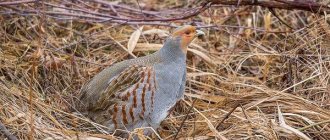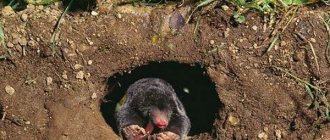- August 29, 2018
- Hunting
- Natali Michaelis
Mole hunting was once considered a fairly profitable activity. In the post-war years, particularly skilled hunters earned good money from this. The procurement offices accepted valuable skins for a good price. Plus, special coupons were given that made it possible to purchase various goods that were in great short supply at that time. However, today this type of hunting is gradually losing its popularity. Extraction of ordinary furs has become a very common and familiar activity. Most professional hunters believe that mole hunting is an extremely unprofitable and uninteresting activity. Is it really? Let's figure it out.
Features of mole hunting
Only a madman or someone who has no idea what this activity is like would go after this animal with a gun. It may seem to a novice hunter that hunting moles is a pointless and boring undertaking, but this is far from the case. If you taste all the delights of mole hunting just once, you will be captivated by this activity forever and will recommend it to all your friends and acquaintances. Perhaps if every skeptic tried this “strange” activity at least once, his opinion about mole catchers would change significantly.
Material dividends are not all that hunting animals can bring. From an emotional point of view, this type of hunting will allow a new look at nature even for those individuals who “see” it quite rarely. As a rule, moles begin to be hunted when the fields bloom with different colors, the smell of black currants is fragrant in the air, and young mushrooms begin to attract with their recognizable caps. This is the time when the aroma of freshly cut hay and meadowsweet is in the air.
However, despite all the above-mentioned romance, catching moles will not be easy. Like any other craft, this activity requires great dexterity and certain skills. It is worth knowing a lot about the biology of the animal, especially where exactly it lives.
Working mechanisms
If the mole population exceeds 5-10 individuals, then you cannot do without traps. They work flawlessly. You can make the structures yourself, but it is preferable to purchase spring triggers in specialized stores. Thus, you will not get hurt during the manufacturing process, the design will be durable, and in case of breakdown or failure to perform functions, you can always order repairs using a warranty card.
Trap for an underground animal
A mole trap is a ready-made device, upon contact with which the animal is killed by suffocation or fracture of the cervical vertebrae. The basis for traps is a wire base.
You can free territories from moles using scissor traps, plunger mechanisms, all kinds of nooses, and crossbows.
Catch with a scissor trap
By choosing a trap presented in a design similar to scissors, you will certainly know that it has worked. This type of mole trap is quite well known among gardeners due to its advantages:
- It's easy to install. You need to insert the handles into the soil and cock the mechanism.
- You can see that the trap has worked even from afar.
- Sensitivity is adjustable.
Disadvantages of the pest control method:
- The small size is sometimes not enough to place the device in a tunnel at depth.
- If you don't adjust the sensitivity, it triggers on leaves, stones, and nuts.
- In cold weather, frozen handles do not function.
Since the main harvest time is the summer-autumn season, and fresh passages are located near the surface, the disadvantages will not play a decisive role during the purchase.
Skat-1 system against the blind beast
Plunger designs
In terms of efficiency, plunger designs are not inferior to scissor traps. There are two main types: “Scat-1”, “Scat-2”. A mole trap, regardless of type, is designed to kill underground inhabitants.
The operating principle of Skat-1 is similar to the operation of a crossbow. To start work, you need to stick the legs into the soil on the sides of the mole's hole, cock the spring, which inserts the guard into the hole.
Hitting the guard, a spring is activated, which releases three spokes into the mole, killing the animal.
How does Skat-2 work? Catching occurs similarly to the first plunger design, only, having touched the guard, the staples clamp the pest, breaking the backbone or limbs.
This method of fighting is considered professional, although live traps will bring more results, since after the plunger mechanism is triggered, you need to re-tension the spring, but a large pipe can accommodate 2-3 adult individuals at once.
Will a loop trap work?
A suffocating trap for a mole is made of wire. This loop is easy to make yourself. If you don’t have enough time, then similar mechanisms can be found in agricultural stores; the price relative to other traps is not so high.
Like any type of trap, a wire loop is laid in the move. Crawling through a round hole, the mechanism is triggered, and the mole is squeezed by a deadly noose.
The device is designed for reusable use, so that by purchasing several traps, you will be able to clear the land of moles that prefer to settle in families.
Harpoon fishing
Another type will be various crossbows. This rather labor-intensive process of catching moles can harm even humans. How does a mole trap work?
Harpoon for catching underground animals
- A pipe filled with gunpowder and shot, sealed on one side, is used.
- Nichrome wire is connected to the gunpowder.
- In the same way, connect the motion sensor at a distance of 20-30 cm from the crossbow.
- As the sensor passes by, the wire heats up and the device kills the animal.
An absolutely inhumane method of fighting is not only labor-intensive, but in most cases it is useless, because if the mechanism does not work, the animal will be injured and will die for a long time and painfully.
A mole is not a fish
Particularly “sophisticated” hunting enthusiasts recommend catching moles with a hook. Such an action is inherently useless, since the animal is injured and ultimately dies. How do you catch moles with hooks?
Triple fishing hooks on the fishing line are lowered into the hole, bringing the rest of the fishing line out. While making its way in search of food, the mole runs into sharp hooks that pierce the skin. Trying to free itself, the animal begins to move convulsively, thus moving the stick to which the fishing line is attached.
It is almost impossible to pull out a hook that is caught in the muscle fibers of the animal, and the mole slowly dies for several days from the injuries received and lost blood.
Where do moles live?
In our country you can find 4 species of moles, but they hunt exclusively for the common mole. It is found throughout almost the entire territory of Russia - from the Don steppes to Arkhangelsk and from Transbaikalia to the western borders.
A mole can settle almost anywhere, but it prefers copses and forests. Small concentrations of this animal can be found in deciduous forests, but it has nothing to do in swampy areas. Moles are also often found in gardens and summer cottages. This pest loves to eat the young roots of bushes and garden crops, so people try to get rid of it in every possible way.
How to Catch a Mole: The Proven Best Way
Everyone wants to have a beautiful, smooth and green lawn on their property.
Now imagine this situation. One day you decide to surround your home with a beautiful living green carpet. We bought expensive lawn grass seeds, dug up the entire area by hand with a shovel, leveled it with a rake, and sowed the grass. Then she finally rose. It starts to grow, you water it abundantly, it grows even better. And now you are already cutting it. Relax on it, walk barefoot. The grass is thickening, you like it and it seems all your work was worth it. But. One morning you go out and see something like this:
Krotolovka
Have you thought about how to get rid of moles in your garden? A standard mole trap is perfect for this purpose. Just a few decades ago they were quite primitive, but with the development of technology these devices have improved significantly, becoming even more effective. You can buy such a thing at most hardware stores that sell mousetraps. By the way, these two designs are quite similar in appearance and functionality, however, the mole trap is slightly larger in size.
Looking for a way to get rid of moles? Self-made traps can help you with this. To do this, you don’t have to resort to various tricks, and the material you can use is ordinary wire, which just needs to be twisted correctly. An analogue is a plastic trap, which is made from an ordinary bottle:
- First, we make the “body” of the pipe by cutting off the bottom and top of the bottle.
- The other two containers will require the tops to be cut off.
- The neck itself must also be cut off.
- In the remaining part we cut ribbons that are tightly driven into the pipe.
Such a mole trap is installed in holes through which animals move. Crawling through such a trap, the animal will easily push the ribbons apart, but will not be able to get back out.
DIY making
If it is impossible or unwilling to kill pests, alternative options are used, homemade traps, which allow you to catch a living mole. The basis is a plastic pipe with a diameter of 7.5 cm and a length of 20 cm. Algorithm:
- A door is installed at one end that opens only inward. Tin door (thickness 1 mm).
- Ears with holes are made in the upper part of the door. Cut the top of the workpiece, retreating 1 cm and bending the cut edge.
- A wire grill is attached to the other end.
- Several holes with a diameter of 10 mm are drilled in the upper part to observe the prey.
The principle of operation is simple - the animal gets inside, but cannot get out. All that remains is to take it out with the trap and shake it out.
Ready-made mole trap, made by yourself.
Best time to hunt
You can start hunting moles as early as June 20, when the young animals have grown a little and begin to go hunting. The season ends in late autumn, when the first night frosts strike and the animal goes into hibernation. You can resume hunting immediately after snow falls, but most moles appear in the summer.
During the entire hunting season, you will need to place a large number of traps over a fairly large area, which must be divided into small areas. After the moles stop falling into traps, you can safely move to another place.
Three shovels
A method of catching moles from a series of oddities and for those who have nothing else to do in the country. They can also be classified as traps, although it would be more correct to call them an ambush. This method requires 3 shovels. We stick the first one across the mole passage and trample the earth on both sides. Now we wait for the animal to appear. His appearance will be noticeable by the movement of the earth.
It is unknown when the animal will appear. If you are lucky and the mole is discovered, we stick a second shovel behind the mole. Now, with the third shovel, we quickly dig out the animal before it has time to dig another hole.
Habits of moles in nature
A novice hunter should know all the behavioral features of moles in natural habitats, which can be used in hunting this animal. For example, a mole prefers to settle in rich soil, which is rich in insect larvae and earthworms, but at the same time tries to stay away from the lairs of large animals.
As practice shows, in our area moles are most often found in alder forests. If you decide to hunt in the fields, then you need to look for prey along the boundaries, but if in the forest, then near streams, as well as near paths and roads. The most important thing is to be able to distinguish the mole's feeding galleries from the deep-lying permanent entrances leading to the nests. You will definitely find several animals in the nesting chambers.
How to completely get rid of moles in garden plots
Some gardeners are annoyed by moles to such an extent that they decide to take extreme measures to physically destroy them.
They begin to use poisonous chemicals, which, along with their immediate purpose, destroy beneficial earthworms.
Someone (most likely fishermen) even throws their gear into the holes...
Peace to the world!
Natural enemies
Your pets can help you in the fight against moles; for example, cats and dogs (especially dachshunds and fox terriers) are considered to be quite dexterous and skillful hunters of these underground pests. Therefore, take your pets to the dacha more often and let them get their own food in the wild.
Video: Dachshund fights moles (at least he tries)
Choosing a location for the trap
During the hot season, it is best to catch moles along ditches and streams, as well as on trails used by people and livestock for travel. In such places the soil is not so hot, so moles will be found here most often. During the rainy season, it is best to place mole traps directly on the surface, where the prey will crawl out of the water-filled holes.
Permanent and feeding passages are quite often located in close proximity to each other, forming a complex interweaving between them. In order to determine the type of burrows, do not hesitate to dig up the ground and examine them from the inside. If you find a feeding ground, then be sure that there will be a permanent passage nearby. Remember that setting traps in feeding holes is a waste of time.
Types of ready-made traps
There are quite a few ready-made mole traps, for example: scissor traps, tunnel traps, plunger traps, pipe mole traps (also called humane traps) or live traps, ultrasonic repellers. Let's look at each trap in detail.
Scissor trap
There are many options for such devices, which are most often found in gardening stores, etc.
The photo shows a simple example of a scissor trap
Advantages:
- Easy to install (just press the handles into the ground and cock the mechanism).
- You can observe the operation from a distance.
- It is easy to adjust the sensitivity of the device.
- Simple but reliable design.
Flaws:
- Although easy to use, the trap is difficult to install in a tunnel opening, especially at great depths. It must be located and hidden so that the moving parts are not obstructed in the form of stones, pieces of peat, or clods of earth. Due to the tight handles, it is difficult to completely hide the device without light entering the passage, ensuring reliable operation.
- If there are low temperatures in the ground, the handles freeze and the trap does not work.
- Heavy rain can wash away the soil, making the trap undetectable.
- Difficult to install in very shallow and very deep tunnels.
Tunnel trap
The most suitable design for a mole trap is one that includes a semi-tunnel. Such a trap is easy to hide; working parts for the most part do not jam from foreign objects.
Advantages:
- Easy to install in a mole passage. It is enough to pour a little earth on top to block the access of light.
- Quickly and effectively kills pests.
- It is easy to adjust the sensitivity of the mechanism.
- Working parts practically do not jam due to the ingress of stones, peat, etc.
- If you cover the trap with peat or a board, frost and rain will not affect its operation.
- It is used with equal success in deep and shallow tunnels.
- Can neutralize two moles at the same time.
Flaws:
- Complex installation, requires advance instructions. If used incorrectly, you can easily get hurt.
- The operation of the device cannot be seen from afar.
- Invisible above the ground, so if the pointer is lost, the trap will be difficult to find.
Plunger trap
If you prefer to use a scissor trap, then this effective device is worth a try.
This is what a plunger trap looks like Another version of a plunger trap
Advantages:
- The trigger mechanism is triggered in a different way from the previous two types. The trap is activated not by the movement of the mole with its nose or paws, but by pushing through the earth to restore the previously dug tunnel. Thus, the trap is very useful in the presence of moles that bypass the traps.
- A very powerful trap that requires a little practice to use.
- No need to adjust before use.
- Relatively easy to install, but requires a little time, especially when working on rocky soil.
Flaws:
- If there are stones in the ground, it can become stuck, as is the case with a scissor trap.
- If you do not have the skills to install it correctly, the device may not work, and moles will freely pass through it.
Humane mole trap-tube and ultrasonic device
Quite ineffective devices. The first is a hollow tube with movable doors on both sides, the second also has the shape of a tube that is installed in the soil. According to reviews from gardeners, it is almost impossible to get rid of moles using such traps, because moles bypass some of them, while they get used to others or ignore them altogether. However, there are also cases where ultrasound turned out to be effective, as long as it did not become addictive, like any surface noise produced by a person.
Example of an ultrasonic trapHumane tube (not very effective)Ultrasonic mole repeller device
Children's moves
During the period when the young begin to emerge from the nesting chambers, you can try to find the baby tunnels. In such places you can hunt for 5-6 days, and you will have to check the traps quite often - every 3-4 days. Such a find will allow you to catch a large number of animals in a short time. Trapped moles block the passage of other animals, which is why they have to take a detour. Here it won’t be difficult to catch them.
Remember that young animals are slightly different in size from adults, so it is necessary to make traps with the appropriate parameters. If the bottle or wire trap is too large, the animal can easily get out of it.
Mole trap. How to determine the progress of a mole and install a mole trap
When preparing material about moles and measures to combat these animals, information from the last hundred years was used. Books from libraries, websites and forums corresponding to the topic were shoveled. Take note of the advice of experts. Therefore, the acquired knowledge must be modernized to the realities of today (this especially applies to chemicals, etc.) and in relation to a specific site. Let's talk about the most effective way to save a site from moles - about mole traps. Let's find out how to determine the current move of a mole, how a mole trap works.
Setting traps in early spring will help eliminate females that are ready to breed, and this will effectively reduce the problem later. It is very important to choose the right place for the trap; for this you need to determine which of the feeding tunnels is actively used by the mole.
Mole trap. How to determine the current move of a mole
The current (active) surface movement of a mole can be determined as follows: press it down with your foot or spatula, mark this place with something bright (old tape on a stick as a flag) to make it easier to find them later, and then inspect it. If the mole restores its movement within 1-2 days, then the movement is active. Setting traps in permanent or deeper passages is most effective, since such passages are used several times a day. To determine the main path leading into the yard or some part of the garden, find a permanent passage that runs in a generally straight line or connects two mounds of earth or two feeding areas (side passages). Main passages often follow fences, paths, foundations and other man-made boundaries. Sometimes the main path runs along the perimeter of fields or lawns surrounded by bushes and trees. The winding passages on the lawns are "trials" that may no longer be used. Setting traps on such test runs may not be productive.
A mole trap is one of the most effective means for combating small numbers of moles and shrews.
Rice. 1. Standard mole trap:
A—in an alert state; B - in a wary state; 1- input ring; 2 - pressure lever; 3 — hook (protrusion) of the guard; 4 - alert; 5-ring spring (curl).
The most common fishing gear is a standard wire mole trap (Fig. 1), consisting of a frame and a guard. The frame is made from a piece of steel wire with a cross-section of 3.5-4 millimeters. Between the support and pressure levers there is a spiral spring consisting of two and a half turns. The spring should provide an alarming force of 4-5 kilograms and press the animal to the bottom of the entrance ring with a force of 2-2.5 kilograms. The upper (support) lever forms a round input ring, and the lower (pressure) lever forms a U-shaped clamp. When alert, this clamp is raised up and held in this position with alertness. The guard has an earring on which it is suspended from the support lever, a protrusion for holding the clamp and the ring. The guard is located at a certain distance from the entrance hole so that at the moment of release the mole is already inside the entrance ring. Pushing its head alert, the animal releases the clamp, which slides off the ledge and presses it against the entrance ring.
Mole trap. How to alert a mole trap.
The mole trap is alerted in the following way: they take it in the left hand, and with the right hand they pull the pressing (hitting) lever to the crest of the support lever. Then, with your left hand, set the guard and secure it with its protrusion to the pressure lever. The mole trap is put into action. The animal, pushing the ring with its head, knocks down the guard, and the pressure lever presses it against the ring.
Standard mole traps should be adjusted before use. If the spring is weak (this can be checked by hanging a weight of appropriate weight from the pressure lever or using a spring scale), then it can be deployed. To do this, the pressure lever should be removed from the ring, pulled to the side and inserted back into the ring. If the spring force is excessively large, it is necessary, on the contrary, to move the pressure and support levers. The pressure lever must be in the center of the input ring, and that part of it, to which the protrusion (hook) of the guard is hooked, must be parallel to the plane of the input ring (if necessary, this can be corrected by hitting a hammer).
To speed up the alarming of the mole trap, the bend of the pressure lever, to which the alarm hook is attached, is marked with a file notch. If the guard frequently jumps off the shoulder of the comb, a notch is made on the ridge with a file.
An interesting device for inspecting mole traps was proposed by V.G. Bogachev. It consists of a piece of wire 10-12 millimeters long, which is attached to the end of the pressure lever of the mole trap. In a guarded trap, this wire is placed vertically so that it rises 3-4 centimeters above the passage. When a mole hits or the mole trap is lowered, the wire lowers. This serves as a signal to the mole catcher to check the trap.
Before use, all mole traps must be cleaned of rust and placed in a bag in pairs.
In a small area, it is enough to have 4-5 pairs of mole traps. When 15-16 individuals are caught, the local mole population degrades and raids practically stop. But mole traps must be in the holes at all times.
Photo 1 Photo 2
Photo 1 shows mole traps and a file. A file is an integral device necessary for alerting a mole trap.
Important! The heel of the guard and the stop on the shoulder of the crush are carefully cleaned of rust with a file in the LONGITUDINAL DIRECTION, and not in the transverse direction, which contributes to a more accurate and soft operation of the mole trap, and forces the animal to hunt more intensively.
Photo 2 shows how to install mole traps.
Important! The spring of the mole trap is pressed into the ground AGAINST the movement of the animal through the hole!
Rice. 2 Installation of mole traps
Mole trap. How to properly install a mole trap.
The mole tunnel is opened in the right place with a knife. Cut out a layer of excavated earth (approximately 45x25 centimeters) in the form of a rectangle, narrowed downwards so that it does not fall through when closing the hole. The passage is cleared of crumbled earth and debris, then a guarded mole trap is inserted into it so that the spring is directed towards the exit, the edge of the ring is slightly immersed in the bottom of the passage, and the guard does not touch the ground, otherwise it will not work (Fig. 2,3). In the same way, a second mole trap is installed in the same move, but with an entrance ring, i.e., with a guard in the other direction. In front of the trap, the passage must be straight at a distance of at least 50 centimeters.
If the soil is loose, it is better to strengthen the trap by inserting a peg into the hole. Sometimes mole traps are secured by pressing a spring into the bottom of the passage or into an earthen roller. Catchers practice lubricating the entrance ring of the mole trap with a mass of crushed worms or the meat of killed moles, which, in their opinion, increases catchability several times.
Having placed the mole trap, the passage is carefully closed with a removed layer of turf or a rope of grass (Fig. 2). This is caused by the fact that the mole reacts strongly to light and, upon finding open areas of the earth, immediately clogs the vents with earth. The cover should not hover over the trap, so as not to prevent it from working at the right moment. If the trap is not placed carefully, then the moles bypass it, breaking through their passages from the side, above or below. In this case, it is advisable to move the mole trap to another place. In order not to lose the places where the traps are installed, various marks are usually placed: a bush branch is broken, a twig is stuck nearby, etc.
Rice. 3. The best places to install mole traps on uneven terrain.
Placed traps are usually inspected once a day. Usually, during the course of a day, not one mole runs through, but several. If a mole is caught in a trap and thereby blocks the passage, then those following it usually go around it, digging either from the side or from below. Therefore, it is recommended to place an additional 6-8 traps in long passages. During the period of settlement of young animals, when they run in the passages in groups, the placement of additional traps can significantly increase the number of moles caught during the day. Of course, where there are few moles, you should not use several traps. You cannot set many traps in one turn on soft soil, as moles easily bypass them. In this case, three screes can be made at a distance of a meter from the trap and at the same distance from one another. The mole restores the first scree, but quickly approaches the trap and falls into it.
How to catch with a mole trap (advice from specialist N.V. Zhukov).
Be sure to test your new mole trap: load and release the pressure lever several times, because... It happens that the wire from which the trap is made is fragile due to low quality. If the mole trap works on a mole and falls apart, it will be impossible to catch it later. The mole will either cover it with earth or bypass it next time. It is useless to set a trap in a pile of earth that a mole has dug up. Walk around the perimeter of your site. You will definitely find a main entrance through which the animal enters your territory (from a neighboring area or forest). This entrance is used by the entire mole family. The earth here will be raised into a hemisphere. Compact all loose soil near the entrance as much as possible and wait for the moles to restore the passage. Carefully open the tunnel. Charge two traps and insert them into the tunnel with the entrance rings in two opposite directions (since it is unknown which side the mole will go from). Then cover the gear. To do this, you can use a piece of slate, boards or ordinary turf.
Before setting traps, you need to find and select a suitable place for this. It is best to place them at the intersection of forest roads and paths with molehills or between molehills. You can also place a trap at the last single wormhole, since it usually represents a dead end. In surface passages, which the mole rarely uses again, traps should not be set.
Material prepared by: horticulture specialist Buinovsky O.I.
Similar articles:
- Lawn pests and control measures
- Containers for honey or what is the best way to store honey?
- Tutimers - remontant raspberries in Belarus.
- Currants - planting and care
- Lawn diseases and their treatment
Bait selection
Don’t know how to get rid of moles in your garden? Set up a mole trap in the area with some treats for the animal. It will be quite difficult to catch a mole in a trap without using some kind of bait. Experienced hunters recommend using ordinary earthworms for this purpose, since they are a favorite delicacy of moles, and getting them is not difficult. You just need to go out into the garden after the rain and dig the ground several times to a depth of about 20 centimeters. Worms try to settle in fertile and loose soil, so looking for them in fresh humus will be the most rational solution.
After that, we simply put a few worms in a plastic trap. They won’t be able to get out of there, but the smell will attract moles from a fairly large distance. The animal will probably want to feast on such prey and will fall into the trap itself.
You can also use some root vegetables as bait, such as chopped potatoes or carrots. You can purchase special oils that will attract moles from all over the area. For example, mole bait Bros. gives good results. This tool helps to lure moles from a fairly large distance. But experienced hunters still recommend doing it the old fashioned way and using worms as bait for moles in a trap.
Actions after eliminating the animal
Scare and destruction are not a guaranteed solution to the problem. After a while, other representatives may enter the garden. Then all the manipulations are repeated again.
To prevent intrusion:
- fence the perimeter of the site using a special mesh or slate. They are buried in a trench (depth 70 - 80 cm). The height above the surface is 20 cm. A solid strip foundation is also suitable (more expensive method);
- If the lawn is damaged, lay the mesh in a horizontal position, lowering it to a depth of 5–10 cm under the required area.
Such work and materials cost a lot. Not everyone will do this.
Several important features
At the end of summer, it is recommended to install mole traps in large numbers and check them more often for the presence of prey, since at this time the animals begin to break up into pairs and actively reproduce. On one turn, you can catch two moles at once, and then move the traps with bait to another place.
It is worth noting that you should not install mole traps on every move found, since in this case you may simply not have enough traps. It is best to find a hole that has the smoothest and most compacted walls. We install several mole traps in it, and trample down the remaining passages. This will force the animals to use the path in which your traps are located.
To install mole traps, it is recommended to use areas that intersect with dense soil, for example, paths, roads, and so on. In these places, several animals use the passages at once, and not just one. Why is that? The fact is that in dry weather it is quite difficult for moles to break through compacted soil, and they somehow need to move from one place to another. That is why near the roads there are most of the discarded heaps of earth that other moles left here.
It is worth noting that if you decide to install a mole trap near a road where heavy vehicles and tractors often pass, then be prepared for the fact that the traps may slam shut due to vibrations. To prevent this situation, you need to add a little earth to the trigger. Or you can use ordinary plastic mole traps made from bottles, which do not have a complex mechanism.
In places where livestock graze, it is necessary to install 2-3 sticks or perches above the traps. This way, the animals will step over obstacles and the traps will remain intact. Also, do not forget to put mole bait, otherwise you will not get much results from the hunt.
Odorous liquids and substances
First of all, it is necessary to determine the path of the animal. In each fresh molehill you need to make a small hole. You can use a stick or drill for this. You need to get to the horizontal gallery. Pour one glass of the special mixture into it. It is prepared from kerosene and fuel oil in the following ratio: 1 to 2. After this, the hole must be filled with earth, then trampled with feet. You can also put the following in molehills:
- Shag.
- Tobacco.
- Bleach.
- Rotten fish.
- Pieces of mothballs.
- Tow soaked in tar or oil.
Due to the bad smell, moles leave the area. At first, these measures will surprise the animal, and it will go away for a while. However, this does not exclude the possibility of the animal returning to its previous areas.
Alternatives to Traps
There are cases when traps, for one reason or another, are not suitable for use in a particular area. For example, when the owner of a garden plot does not want to kill moles, or does not have the time and desire to install traps himself.
In these cases, traps can be replaced:
- Live traps - purchased and homemade. Moles can be caught in a pipe trap, or in a hole made from a bucket or pan, buried under the passage. Some craftsmen manage to dig up a mole with a shovel, simply by lying in wait and throwing it to the surface. The cost of industrially manufactured live traps for moles is approximately the same as that of traps (from 300 rubles and above);
- By calling a special service, whose workers will do everything on their own. This is a more expensive option (the price of services here starts from 2,000 rubles), but it does not require any effort on the part of the owner of the site;
- Mole repellers - in many cases, they effectively drive animals away from the area, although they do not provide such reliability as traps. It may be advisable to try using repellers before using traps, and if they do not help, then start catching moles.
On a note
There are also ways to catch moles with fishing hooks, although this is a completely savage way of fighting, so it should not be considered as a rational option.
In general, it should be noted that most mole traps have approximately the same effectiveness. This means that you should use those that are optimal for each site owner in terms of installation complexity and price. For most gardeners, simple, inexpensive wire traps are sufficient.
Useful video: details about the wire mole trap
How to recognize molehills?
Not only a mole can dig the ground on a site. Similar activity is also typical for gophers, mole rats, and voles. Identifying the pest is important because it determines the strategy to combat it.
Moles dig tunnels under the surface of the earth. Such passages are called stern passages. Animals also dig another type of tunnel under the feeding tunnels, combining them into one network. It is because of them that characteristic piles are formed, reminiscent of mini-volcanoes.
The mole rat is larger than a mole; the piles of earth it digs up are almost half a meter in diameter, and it can weigh 10 kg. They form mounds and gophers, but their shape resembles a horseshoe. Voles also dig passages, but they do not leave heaps, but make visible passages under the surface or on it with a diameter of 5 cm.
A few words about homemade mole traps
You can also make a mole trap with your own hands. Moreover, the complexity of the manufacturing work is directly proportional to the complexity of the structure itself.
In most cases, wire traps and crushers are made at home. These works involve difficulties in manufacturing springs, and to obtain a truly working mole trap, it is necessary to harden the wire at high temperatures.
Sometimes such independent production is limited only to finishing a standard mousetrap (or rat trap) with an adaptation for fighting moles. In more rare cases, craftsmen even make harpoon traps and scissor-shaped traps with their own hands.
In any case, making a mole trap yourself in most cases is irrational. The cost of industrial options is low, and the time spent at home making a trap will be more expensive than the money spent on a high-quality purchased device. In addition, even the simplest commercial traps are very effective - the same wire trap for 50 rubles will work just as reliably as a product that would take a whole day, or even more, to make yourself.
How to set traps correctly?
Each trap is installed depending on the principle of its operation, but there are some tips suitable for any chosen method of catching a mole:
- Before installation, you should determine the place most visited by the mole. It is better to choose one of the central passages of the animal, because it returns there most often.
- Humane traps are installed directly inside or below the tunnel, lethal traps are placed above the passages.
- Traps require supervision, so it will take a couple of days to check if a mole has been caught. If during this time the catching method does not produce results, the special device is moved to another move.
Story No. 2.
The next year, several moles appeared on my lawn in different places. Again they all came from a neighbor. No matter how I tried to scare them away (and constantly poured water on me, and set off firecrackers with ammonia, and launched exhaust gas, and buried bottles), everything was in vain.
I managed to catch one mole much like the first one (I saw a fresh pile, started pouring water and it climbed to the top, after which I successfully killed it). After him, another mole appeared in the same holes. This time I decided to try another method that I had not tried before. I dug up a fresh molehill, made sure that he constantly uses it, and buried a plastic bucket in this place. The bucket should be slightly below his moves. After that, I covered this place with a piece of drywall and sprinkled it with earth.
Every day he checked his trap and every day the mole dug half a bucket of earth into a bucket and filled his holes with earth. I removed the earth and again left his passages open for him to return. And after 10 days I found a living mole in a bucket, which fell and could not get out. You can see more about how it was and how to make this trap in my video:
"Pitchfork"
The last, easiest to manufacture device, in appearance resembles a fork with a metal blade welded to it. This is an analogue of an industrial trap of this type.
These “pitchforks” are made by summer residents according to their own understanding. There are no drawings. And this is good, since it is not difficult to kill a mole, it is more difficult to tense up and take it away. Still, moles are more beneficial to the ecosystem than harmful.
The outer teeth of the “forks” are the “legs” of the trap that hold it in a vertical position. The working part is average. It is a hollow tube into which a harpoon is inserted. The harpoon is fitted with a spring, the ends of which are secured to the harpoon and the tube. When the trap is set, the spring stretches, and when released, it contracts, and the harpoon pierces the animal’s body with force.
The “trigger” is the same “spatula”, fixed movably. It has a groove that allows the harpoon to be held in the upper position. When the mole throws dirt onto the spatula, it moves and the harpoon falls. But such a trap will require serious skills in working with iron and the ability to weld parts, so it makes sense to consider easier-to-make traps that are accessible even to single summer residents.
Mole trap
Review
I tried to set a trap from a store in the form of a pipe. Moles are not so bad, they go around. I found a video on YouTube on how to make a mole trap in the form of a pitchfork with a harpoon. I spent two days making it. Not only that, but it turned out to be difficult to install so that it would work properly. Moles are also different. The principle there is based on the fact that the trap is triggered when the animal throws the earth onto this trigger blade. And different moles throw earth at different distances. I was tired of changing the distance of the “scapula” from the trigger device. And go chase these moles. Every time you have to dig this trap again. I chased one specimen for two weeks and dug up the beds just as well as he did. He spat and moved on to the buried cans.
Maxim, s. Zhuravkovichi
The disadvantages of all such mechanical traps are that they have to be reinstalled each time, digging them in a new place. If earth or stones get into moving parts, the traps do not work correctly. When one mole is caught, these traps no longer work until they are set again. In live traps you can catch as many animals as will fit into the container. Yes, and killing animals just because they lead their usual way of life is wrong. It is not they who have invaded our home, it is we who are destroying their habitat.











